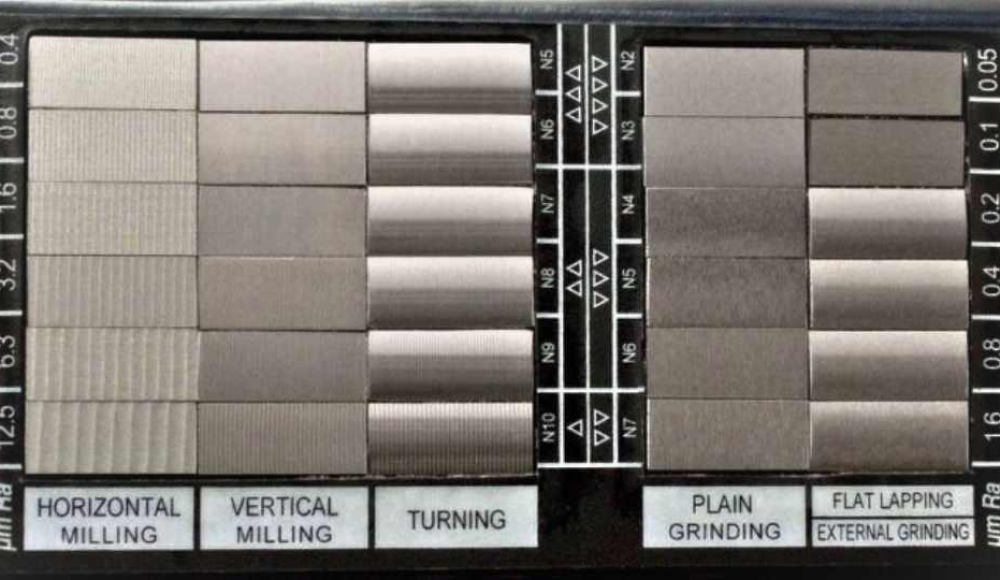Controlling surface roughness is essential for top quality. Surfaces tend to wear out faster because of high friction. Result in damage to the material and the development of defects. Discontinuities on the surface provide potential sites for crack initiation and corrosion. Whereas, controlled roughness enables proper adhesion to be formed between the substrate and the coating material. Thus, leaving surface finishing as an option for guesswork is not advisable at all. If surface finish is important for your product this guide assists.
Surface Roughness in CNC Machined Parts
CNC machining is largely determined by the surface finish of the workpiece as well as the cutting tool. For the most part, the ‘as machined’ surfaces are characterized by an average roughness of Ra 3.2. On these surfaces, marks left by the cutting tools are discernible. Such roughness levels can be used for most of the components. However, some applications call for a smoother surface to be formed on the treated material. The sliding components are advantaged by the smoother surface finishes. Low friction improves wear properties satisfactorily. This smoothness in many cases, means that the workpiece will need further operations or operations such as polishing to get the desired finish.
Minimizing surface roughness is generally costly. Sometimes, it is more desirable to have a more non-uniform surface. For example, the friction between a bicycle seat post and a bicycle seat needs to be relatively high. So, the bicycle seat does not slip from the bicycle seat post when in use. This means that roughness may not be attained just by machining alone. Others like bead-blasting, and tumbling finishes can also add to the texture of the surface in one or the other. The surface roughness obtained normally depends on the machining operation and any subsequent finishing processes done.
Why does Surface Finish Matter in Manufacturing?
The surface roughness of a product is proportional to the product’s environmental contact points. The functional performance of components is defined by the way they are finished. The roughness level also determines the extent of the effectiveness of the product being developed.
In each of the applications, surface finishing remains a crucial area of concern to the engineers. A smooth surface offers more dependable results and smaller tolerances for the build of a part. Flaw measurements show that it is possible to control the surface finish and the manufacturing processes. All of these measurements give an understanding of how surface engineering can be improved.
Such surface finishes can affect the corrosion and chemical resistance of the material in use. Increases the aesthetics of the surface; enhances the adhesion of the coating; and, enables electrical conductivity. Roughness control also reduces roughness and improves wear characteristics.
How Surface Roughness is Measured?
Surface roughness refers to the relative texture of a material surface. The most commonly used parameter of roughness is the parameter Ra.
Three factors impact surface characteristics: roughness, waviness, and lay. Each factor determines how geometry controls the contour of the material.
Various scales are used for measuring the surface roughness parameters. These are direct approaches, indirect approaches, and relative methods.
Direct methods employ a stylus which is passed across the surface profile in a similar way as the stylus shown in the figure below. The stylus records measurements in a direction that is at a right angle to the surface of the material under investigation.
Non-contact methods use sound waves or optical instruments in their place. Surface profiles can be detected by light sensors, microscopes, or ultrasound pulses.
Comparison methods employ ready-made roughness samples for the test of touch. Manufacturers use samples that have known parameters of roughness to compare with their surfaces.
In-process techniques utilize magnetic materials for the determination of surface roughness. Inductive systems measure electromagnetic distance from the material’s surface.
Techniques of Assessing Surface Roughness
There are several approaches for the precise measurement of surface roughness. These techniques are categorized into three main types:
- Profiling Techniques: A high-resolution probe measures the roughness of the surface of a material. This method looks like the working of a fine phonograph needle. Present-day CNC probes may not have the kind of sensitivity required for measurement purposes.
- Area Techniques: These methods provide statistical information on certain surface areas. Examples of the above are optical scattering, ultrasonic scattering, capacitance probes, and others.
- Microscopy Techniques: The intended approach is founded on the differences in contrast on surface phases. It helps to identify material roughness and smoothness, and the presence of ridges or troughs to a great extent.
Symbols and Abbreviations Used in Surface Roughness Charts
While exploring machining surface finish symbols, several abbreviations appear for measuring surface finish, including:
- Ra – Average Surface Roughness.
- Risk– Skewness
- Rq – root mean square roughness
- Rku– Kurtosis
- Rz – mean of the maximum profile height
- Rmax– Depth of the Roughness Symbol
Key Parameters
Ra (Average Surface Roughness):
Often called CLA or AA. Ra is the arithmetic mean of the actual profile roughness about the centerline. Ra is employed to assess surface finish.
Rmax (Maximum Roughness Depth):
Rmax defines the height from the highest point to the lowest point. This parameter is useful for the detection of flaws like burr and scratch and the result shows higher sensitivity compared to Ra.
Rz (Mean Maximum Altitude of the Profile):
Rz determines the average of the five greatest vertical distances between the top and bottom of waves. This approach eliminates the chances that Ra may miss while inputting the data.
Surface Finish Conversion Chart
This chart compares different surface roughness scales for manufacturing processes, incorporating several commonly used abbreviations:
| Ra (micrometers) | Ra
(micro inches) |
RMS (micro inches) | CLA (N) | Rt (microns) | Cut-off Length (inches) |
| 0.025 | 1 | 1.1 | 1 | 0.3 | 0.003 |
| 0.05 | 2 | 2.2 | 2 | 0.5 | 0.01 |
| 0.1 | 4 | 4.4 | 4 | 0.8 | 0.01 |
| 0.2 | 8 | 8.8 | 8 | 1.2 | 0.01 |
| 0.4 | 16 | 17.6 | 16 | 2.0 | 0.01 |
| 0.8 | 32 | 32.5 | 32 | 4.0 | 0.03 |
| 1.6 | 63 | 64.3 | 63 | 8.0 | 0.03 |
| 3.2 | 125 | 137.5 | 125 | 13 | 0.1 |
| 6.3 | 250 | 275 | 250 | 25 | 0.1 |
| 12.5 | 500 | 550 | 500 | 50 | 0.1 |
| 25.0 | 1000 | 1100 | 1000 | 100 | 0.3 |
| 50.0 | 2000 | 2200 | 2000 | 200 | 0.3 |
Surface Roughness Chart Cheat Sheet
The cheat sheet provides a quick reference for understanding various surface finishes and their applications:
| Micrometers Rating | Microinches Rating | Applications |
| 25 | 1000 | Rough, low-grade surfaces from saw cutting, and rough forging, suitable for unmachined clearance areas. |
| 12.5 | 500 | Rough, low-grade surfaces from coarse feeds and heavy cuts, including turning, milling, and grinding. |
| 6.3 | 250 | Surfaces resulting from grinding and milling are used for the clearance of surfaces with stress requirements. |
| 3.2 | 125 | Recommended for parts subject to vibrations, loads, and high stress. |
| 1.6 | 63 | The good finish is produced under controlled conditions, involving fine feeds and high speeds. |
| 0.8 | 32 | High-grade finish needing close control, preferred for products not requiring continuous motion. |
| 0.4 | 16 | High-quality surfaces from emery buffing or coarse honing, are important for smoothness. |
| 0.2 | 8 | Fine surfaces produced by lapping, buffing, or honing, are used where sliding surfaces are necessary. |
| 0.1 | 4 | The refined surface is offered through lapping or honing, typically for mandatory design requirements. |
| 0.05 | 2 | Most refined surfaces for sensitive precision gauge blocks are achieved through the finest finishing methods. |
Factors Influence Surface Finishing Roughness
Machining surface finishes depend on the following factors The type of cutting tool, feed rate, depth of cut, cutting speed, and the type of material being machined. The following key elements play significant roles:
Type of Coolant Used
Coolants improve the surface finish and the life of the tools used in the machining process. They also help eliminate friction throughout the process. Roughness is created by heat that is produced during the process of CNC machining.
Higher-pressure coolant is better on the surface finish of the workpiece but it is not always efficient. It is sometimes actually beneficial to use the lowest quality coolant a car is capable of. This approach reduces roughness and is affordable. It also cuts down on pollution while also extending the life of the tools.
Cutting Parameters
Cutting parameters are very important to have the right surface finish. These consist of feed rate, depth of cut, and cutting speed.
Consequently, it was observed that increasing cutting speed generally leads to reduced surface roughness. On the other hand, increasing the depth of the cut increases the value of maximum roughness. A higher feed rate normally results in a reduced average roughness.
All the cutting operations are reduced in surface roughness by cutting fluids. They reduce the temperature of the tool and the contact surface when cutting. Moreover, fluid penetration helps to reduce interaction between the tool and the workpiece.
Machining Process Types
The machining process has a strong effect on the surface roughness. Two primary parameters govern this: feed rate and cutting speed.
Interestingly, in CNC turning both parameters have an impact on the surface finish. An increase in feed rate leads to a large increase in surface roughness. Higher cutting speeds entail better finishes most of the time.
Vibrations
Consequently, vibrations from the worn or unworn tools influence the surface finish of the workpiece. The surface finish is affected by worn tools because they remove material in a manner that leads to surface roughness irregularities.
Vibration frequency and amplitude determine the quality of the surface of the vibrating parts. As sine wave amplitude increases, average roughness levels are lifted. Variation in vibration frequency has little impact on the general smoothness of the surface.
These factors collectively determine the final surface finish of the workpiece. So, it’s important to recognize their impact to improve the functioning.
Conclusion
Maintaining surface roughness is very expensive and difficult in most of the modern industries. Surface finish is dependent on the rate of surface hardening. Topsbest offers quality surface finishing solutions at reasonable charges. Our specialists know how to provide the required standards of the surface finish by the set specifications.
At Tops, the detailed dimensional inspection report guarantees standard results. Our offer diverse finishing options including anodizing, electroplating, bead blasting, polishing, brushing, and many others. The quality of services ensures higher quality and satisfaction of on-demand services. We have the skills and tools required to improve your products if that is what you require. Contact us through email today because our team is always on standby.




1 thought on “Surface Roughness Chart: Understanding Surface Finish In Manufacturing”